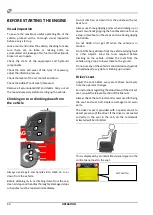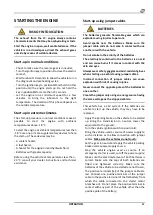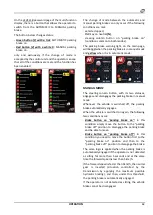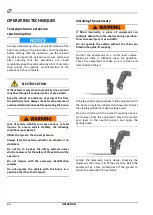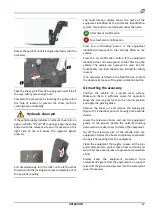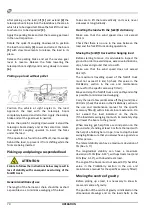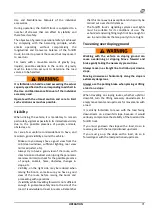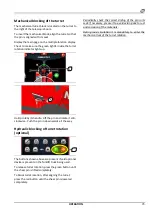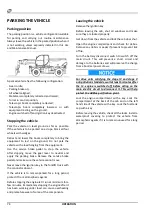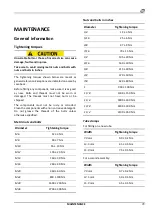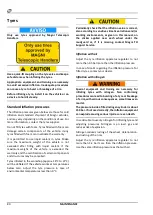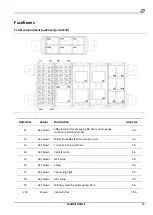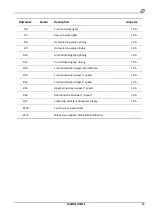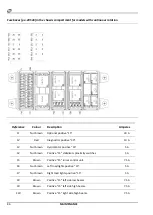
72
OPERATION
Climatic conditions of use
It is recommended to always take into account the
climatic and atmospheric conditions of the place of
vehicle use.
The vehicle is designed for use in different
temperature, humidity and altitude conditions.
However, it is still advisable to observe the values
below:
Parameter
Values
Operating temperature
from -20 °C to +40 °C
(from -4 °F to +104
°F)
Storage temperature
from -25 °C to +50 °C
(from -13 °F to +122
°F)
Humidity
from 20% to 95%
Altitude
< 2500 m
(< 8200 ft)
For use in extreme cold conditions, it is necessary to
install a few additional devices to help with start-up
(e.g. coolant, fuel, engine oil and/or hydraulic oil
heater, higher capacity batteries, etc.)
Contact your dealer or the After-Sales Service for
recommendations and technical assistance or consult
the
“Start
-
up in extreme climates” and “Setup for
countries with cold climate (optional)” sections in
this manual.
Adverse climatic conditions
Always take into account the climatic and atmospheric
conditions of the place of use.
Using the vehicle in snow
Be careful to use the vehicle and proceed with great
caution in the event of snow falling and/or snow on
the ground as it hides obstacles and objects, it can
cover holes / excavations / ditches, etc.
It is strictly forbidden to operate if the amount of
snow is such that the obstacles and dangers along the
route cannot be clearly distinguished.
In case of snow be very careful not to move away from
the roadside; anything buried along the edge of the
road could cause the vehicle to overturn or damage
some components.
Surfaces covered with snow or ice are extremely
dangerous, operate with great caution and reduce the
vehicle speed as much as possible.
In case of snow operate with great caution, if the
vehicle sinks into the snow there is a risk that it may
overturn or remain buried and/or trapped.
Be very careful when moving on icy ground; as the
temperature increases, the base becomes loose and
slippery.
Using the vehicle in wind
The variation in wind speed can lead to many
problems such as loss of vehicle stability, swinging
load, reduced visibility due to rising earth, dust,
leaves, etc.
Unfavourable factors for vehicle use are:
˗
Location of the site: the aerodynamic effect of
buildings, trees and other structures can lead to an
increase in wind speed.
˗
The height of the extended boom: the higher it
extends vertically, the more the wind speed is
perceived.
˗
The load area: the more area the load occupies, the
more it is affected by the wind force.
Near gale
Magni telescopic handlers can be used up to a wind
speed of 36 km/h equal to 10 m/s (5 on the Beaufort
scale) measured on the ground.
Wind-Chill effect
NOTE: At a temperature of 10 °C, a wind speed of 32
km/h (8.9 m/s) makes the exposed parts of the body
feel
a
temperature
of
0
°C.
The higher you climb, the more the wind speed
increases and the more the feeling of a drop in
temperature increases.
In the presence of strong wind (5 on the Beaufort
scale) never lift loads with a surface area of more
than 1 m².
Summary of Contents for RTH 4.18
Page 6: ......
Page 27: ...SECTION ON PRODUCT INFORMATION 27 DIMENSIONS RTH 4 18 RTH 5 18 ...
Page 28: ...28 SECTION ON PRODUCT INFORMATION RTH 5 21 RTH 5 23 ...
Page 29: ...SECTION ON PRODUCT INFORMATION 29 RTH 5 25 RTH 6 21 ...
Page 30: ...30 SECTION ON PRODUCT INFORMATION RTH 6 23 RTH 6 25 ...
Page 78: ......



